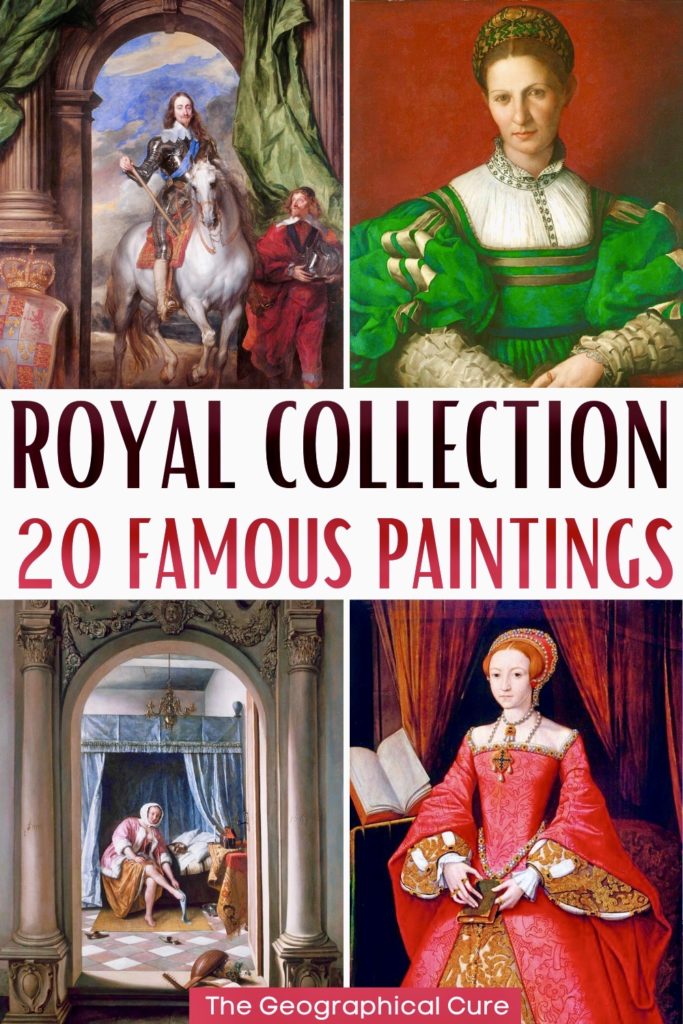Wondering what’s in the vaunted British Royal Collection? Here are 21 famous paintings to discover. I describe these must see art works and tell your where to find them in Britain.
The collection is the world’s largest private art collection, valued at a staggering £10 billion. It was formally established in 1993 by Elizabeth II. The collection is held in trust for each sovereign who succeeds to the throne.
The collection has immense historical significance, as well as showcasing art works from the greatest geniuses in art history.
The collection is especially rich in old masters. It boasts an unrivaled set of Leonardo drawings, almost 30 Canalettos, and paintings by stars like Rembrandt, Vermeer, Holbein, and Caravaggio.
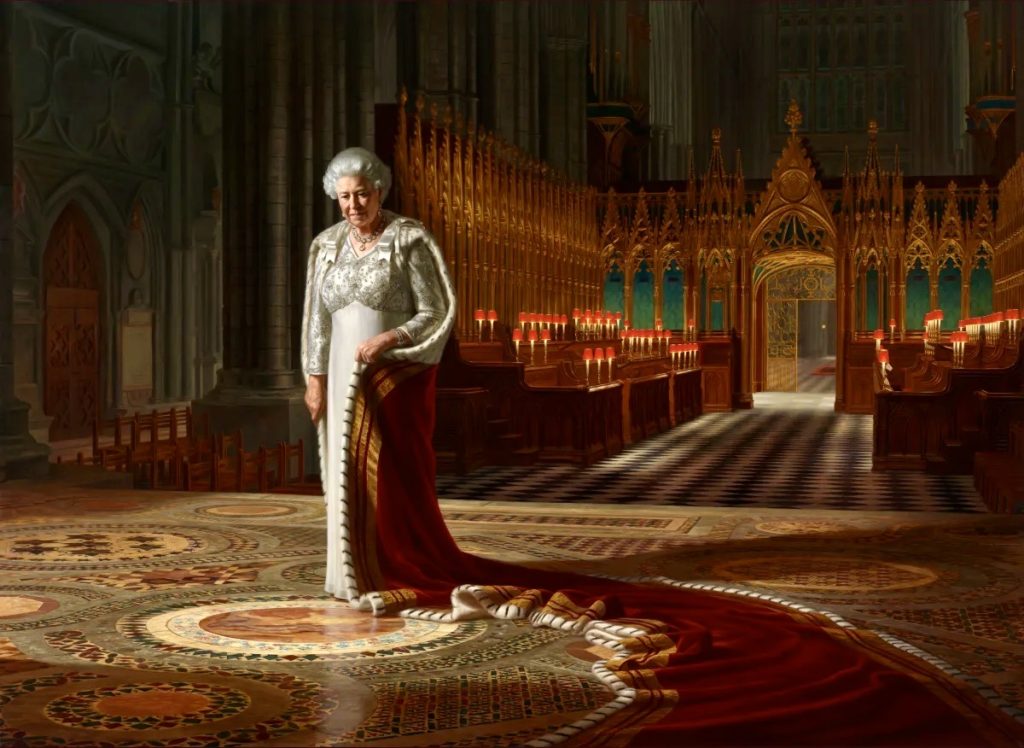
A Short History Of The British Royal Collection
The majority of the British Royal Collection post dates Henry VIII. It spans 500 years from the Tudors to the Windsors.
No art historian or art expert put it together. Rather, it’s a personal collection assembled by the monarchs themselves.
They chose works of art they loved and often commissioned contemporary artists to record important events in their lives.
Charles I made the most important acquisitions, assembling a cache of remarkable Italian Renaissance art.
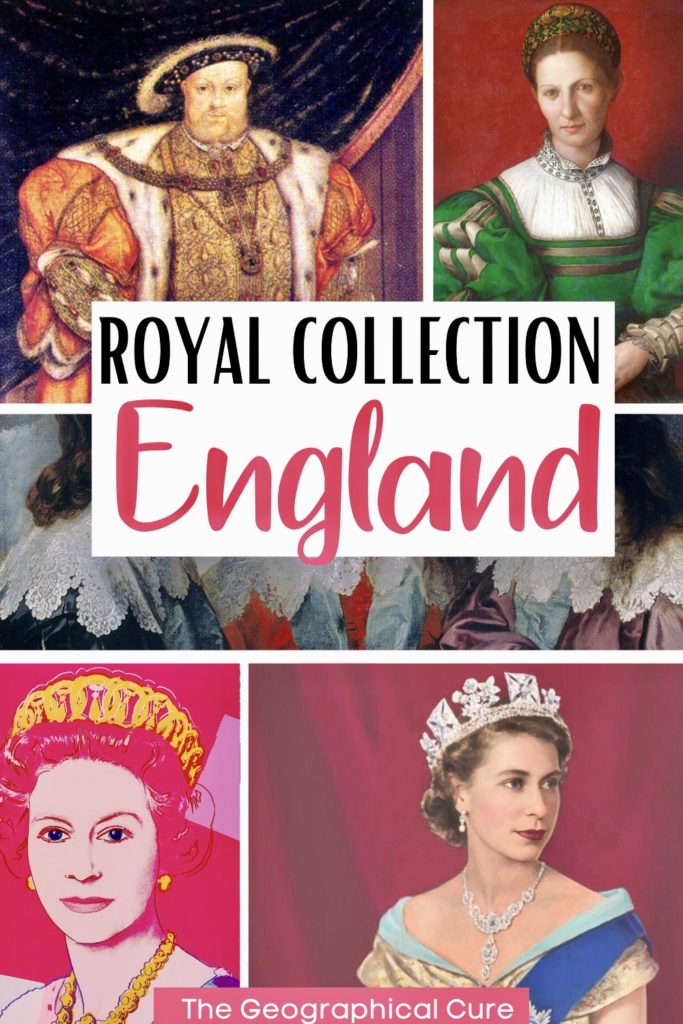
George IV purchased Flemish and Dutch art and commissioned portraits by Joshua Reynolds and Thomas Lawrence.
Queen Victoria and her husband Prince Albert were the other major contributors to the Royal Collection. They commissioned many portraits by the German painter Franz Xaver Winterhalter and collected Medieval art, Italian art, and a wide range of decorative arts.
Together, these three monarchs were true connoisseurs of art, loving “art for art’s sake.”
Charles I was ousted and died during the English Civil War. Most of his collection was sold off by Oliver Cromwell, who despised any form of fun. Some of it now forms the basis of the Prado Museum in Madrid.
After the restoration of the monarchy, his son, Charles II, managed to claw back some of his father’s masterpieces.
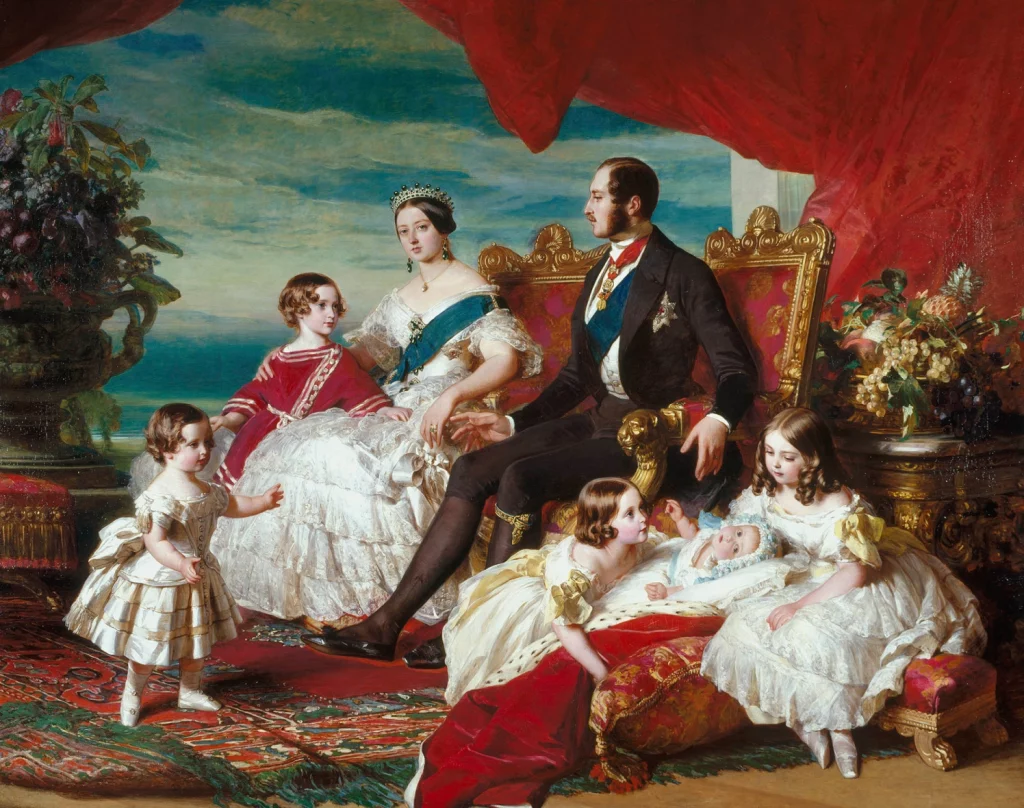
The current Queen prefers horses to art. Still, she has added a few things to the collection. In 2012, she authorized the purchase of four Andy Warhol limited edition prints of herself, in celebration of her diamond Jubilee.
The Royal Collection is housed in 13 various U.K. residences. Elizabeth II has greatly increased public access to the collection.
Many paintings are hanging in royal palaces, which are open to the public. This includes places like Windsor Castle, Buckingham Palace, Hampton Court Palace, and the Palace of Holyroodhouse.
In 2002, Elizabeth II officially opened The Queen’s Gallery in Buckingham Palace and The Queen’s Gallery in Holyroodhouse, to display works of art in the Royal Collection.
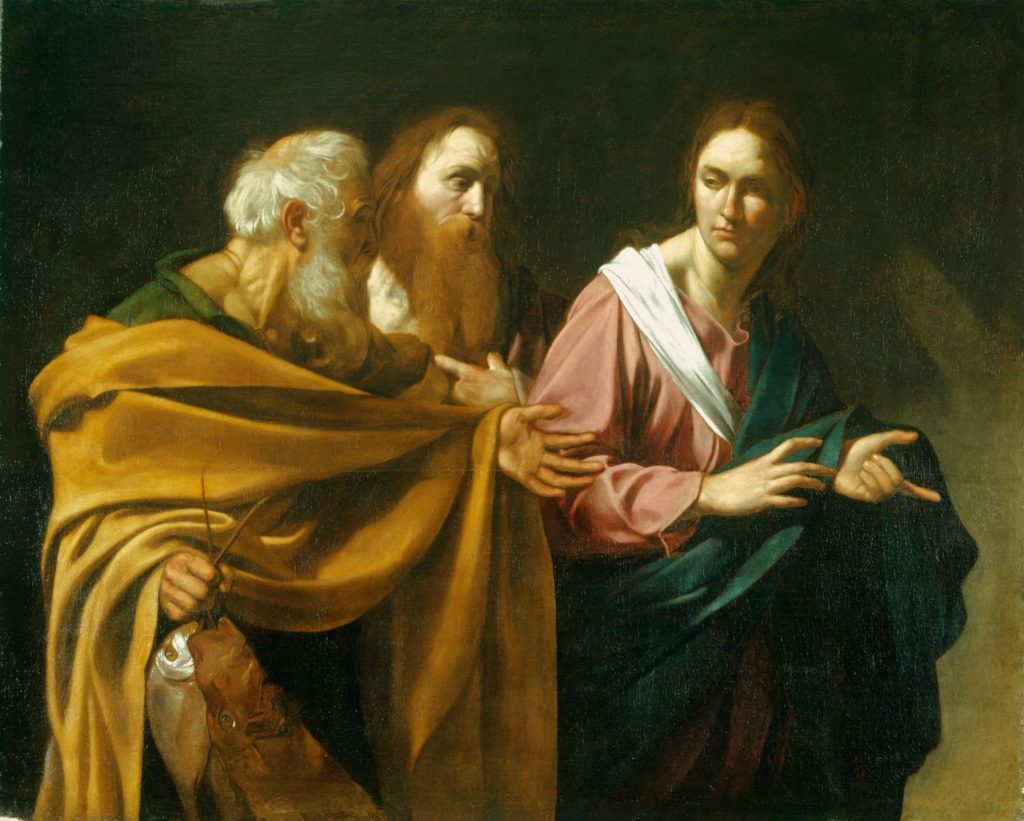
Guide To The British Royal Collection: Famous Paintings
Here are my picks for the 21 most famous paintings in the British Royal Collection.
1. Caravaggio, The Calling of Saints Peter and Andrew, Hampton Court Palace
This famous Caravaggio painting in the British Royal Collection was tucked away in a storage room for more than 400 years. The painting was obscured by varnish and dirt and had been dismissed as a copy.
In 2006, experts from the Royal Collection set about restoring the piece. They confirmed that the painting was a genuine Caravaggio, one of only 50 surviving canvases.
Caravaggio almost single handedly pioneered the 17th century Italian Baroque style. The experts’ attribution has been universally accepted.
In the painting, Christ looks decidely young. He’s calling on the help and expertise of these elderly men who stand to his right. Their expressions are serious but amicable.
>>> Click here to book a ticket to Hampton Court Palace
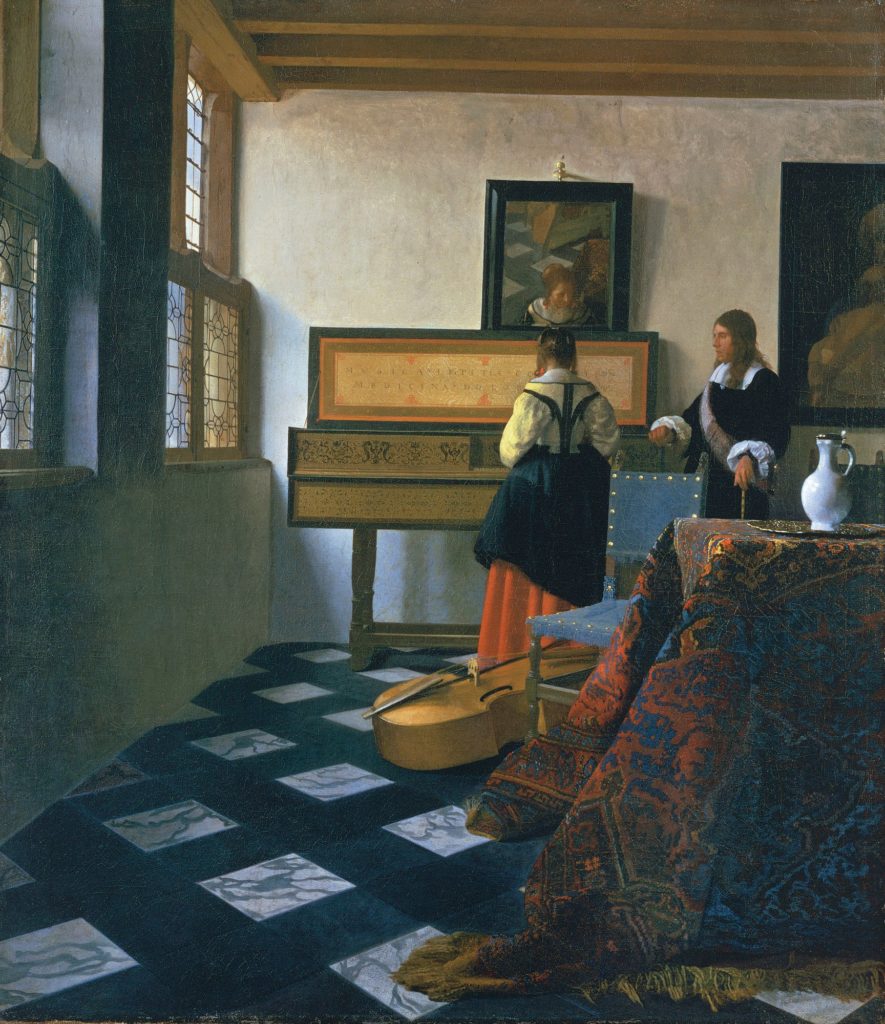
2. Vermeer, A Lady at the Virginal with a Gentleman, Buckingham Palace
Vermeer was one of the premiere painters of the Dutch Golden Age. He specialized in domestic interior scenes of middle class life. There are very few Vermeer paintings in the world.
In this one, two figures make music in a sunlit room. The painting demonstrates Vermeer’s trademark sense of rhythm and stability.
As with all his paintings, light permeates the scene, beautifully rendering his subjects using light and shadow.
The composition uses a rigorous perspective to draw the eye towards the back of the room where the figures are situated.
A striking feature of the composition is the mirror on the wall. In it, you see slightly blurred reflections that include the young woman’s face, part of the table and the legs of an artist’s easel.
>>> Click here to book a ticket to Buckingham Palace
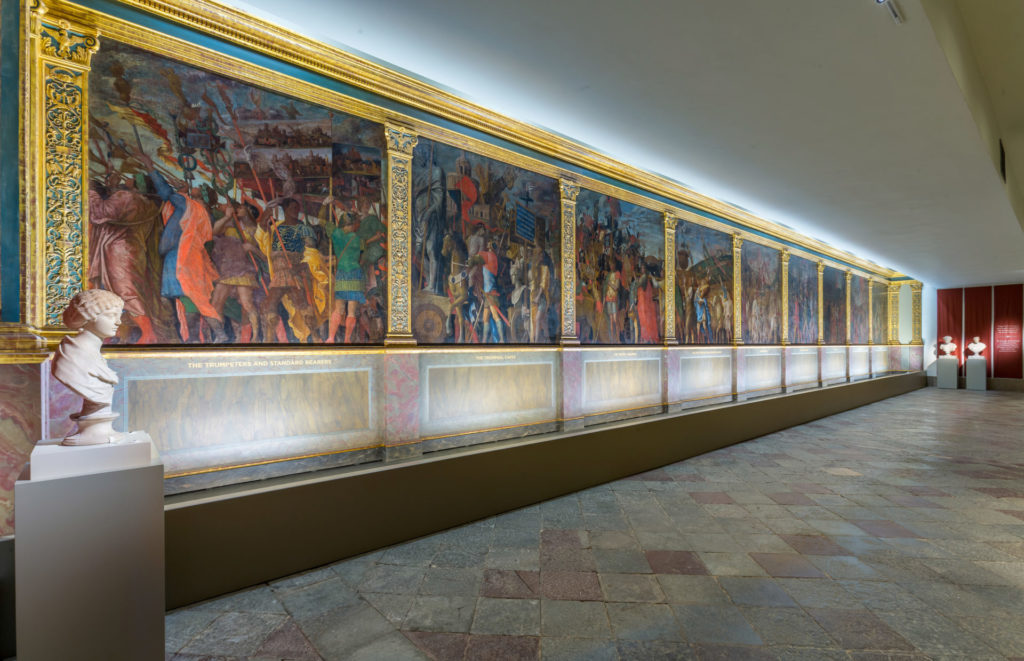
3. Andrea Mantegna, Triumphs of Caesar, Hampton Court Palace
Hampton Court Palace is home to the most important series of early Renaissance paintings outside of Italy. They’re nine large paintings in the British Royal Collection depicting the Triumphs of Caesar by Andrea Mantegna.
Charles I bought them in 1630 from the Gonzaga family in Mantua, who had fallen on hard times. They are now the largest and most significant works of Renaissance art outside Italy.
Art historian Giorgio Vasari called these paintings Mantegna’s masterpiece. They depicts a single procession, culminating in a final episode — the arrival of Julius Caesar on a triumphal chariot after his military success in Gaul.
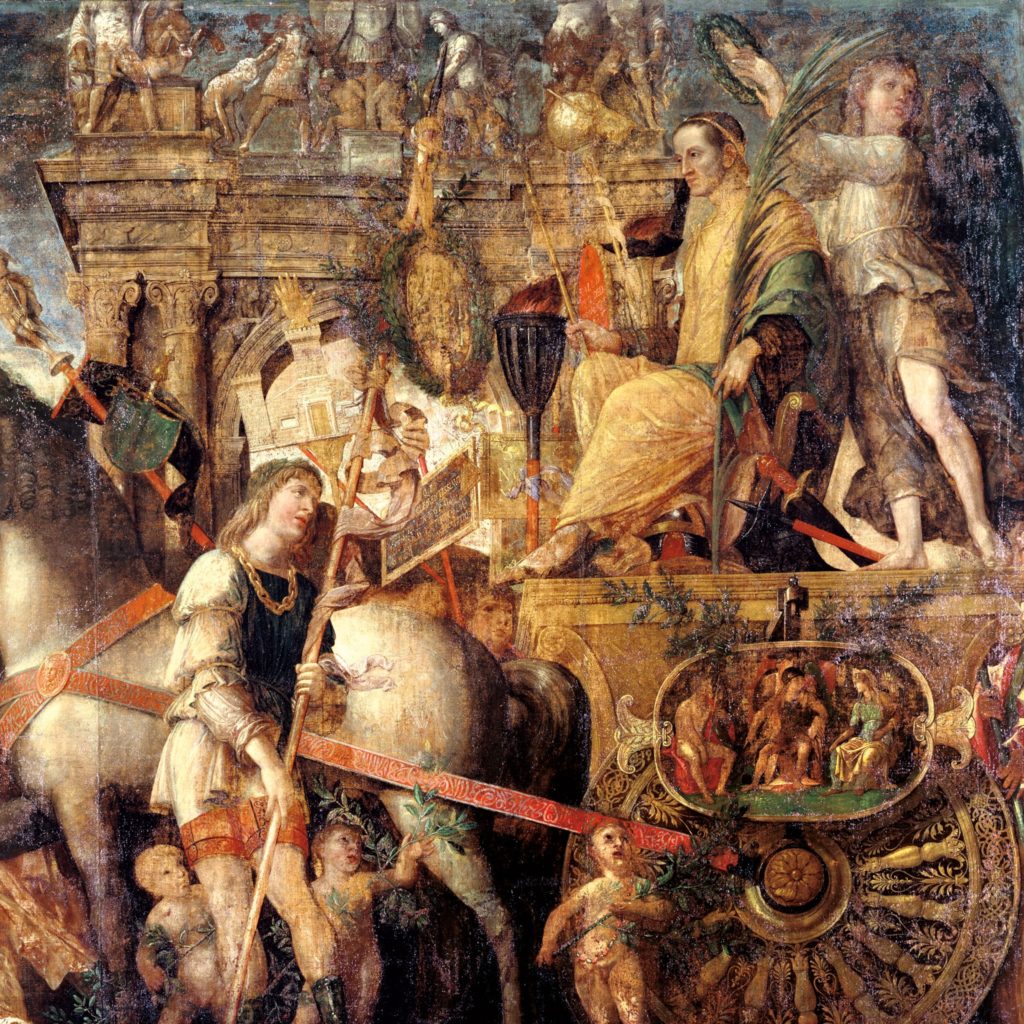
In Ancient Rome, a triumph was a the greatest accolade a general could receive.
The paintings are rendered in Mantegna’s classic style with an almost archaeological precision, a precise linear style, and complex perspectives.
They are not in the best condition. They’ve been restored many times, but most restorations were misconceived.
READ: Guide To Mantegna’s Camera degli Sposi
4. Hans Holbein the Younger, Henry VIII, Hampton Court Palace
The star of the Cumberland Gallery at Hampton Court Palace is Hans Holbein’s famous life size painting of Henry VIII. It examples Holbein’s ability to render a person in a monumental style, but with psychological depth.
It’s also a propaganda portrait.
The portrait is meant to intimidate and convey a favorable impression of the then ailing king. It depicts Henry as aggressive and defiant, exuding unquestionable authority and gravitas.
Henry stands, facing the viewer, holding his gloves in his right hand and the chain from which his dagger hangs in his left.
He is wearing a richly embroidered and jewelled doublet with a fur-lined cloak over, a feathered hat and the Garter.
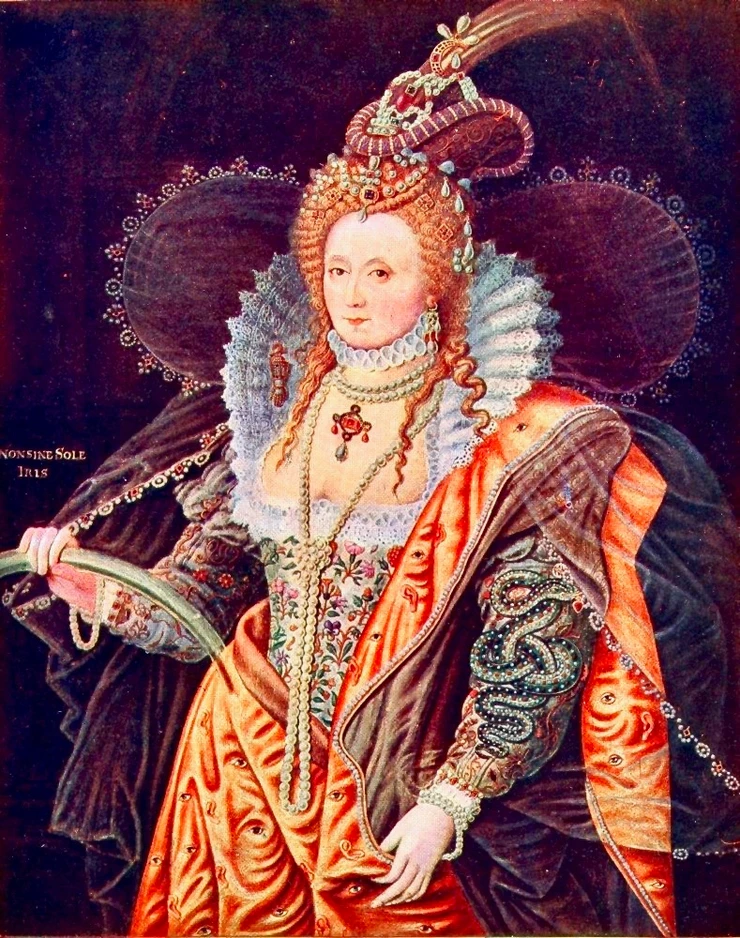
5. Issac Oliver, Rainbow Portrait of Elizabeth I, Hatfield House
Another famous painting in the British Royal Collection is the Rainbow Portrait of Elizabeth I in Hatfield House. In it, she’s a dazzling Sun Queen at the height of her powers.
Elizabeth is shown in a sumptuous orange silk gown, embroidered all over with eyes and ears. The rather peculiar motif represents her ability to know and see all in her court, thereby discouraging plotting. Her glowing red hair is decorated with white pearls, a sign of her purity.
Oliver painted this portrait in the last year of Elizabeth’s reign, when she was 70. Suffice it to say, flattery and an image of immortality substituted for any semblance of realism.
England was, apparently, well behind the rest of Europe, which by then expected an actual likeness.
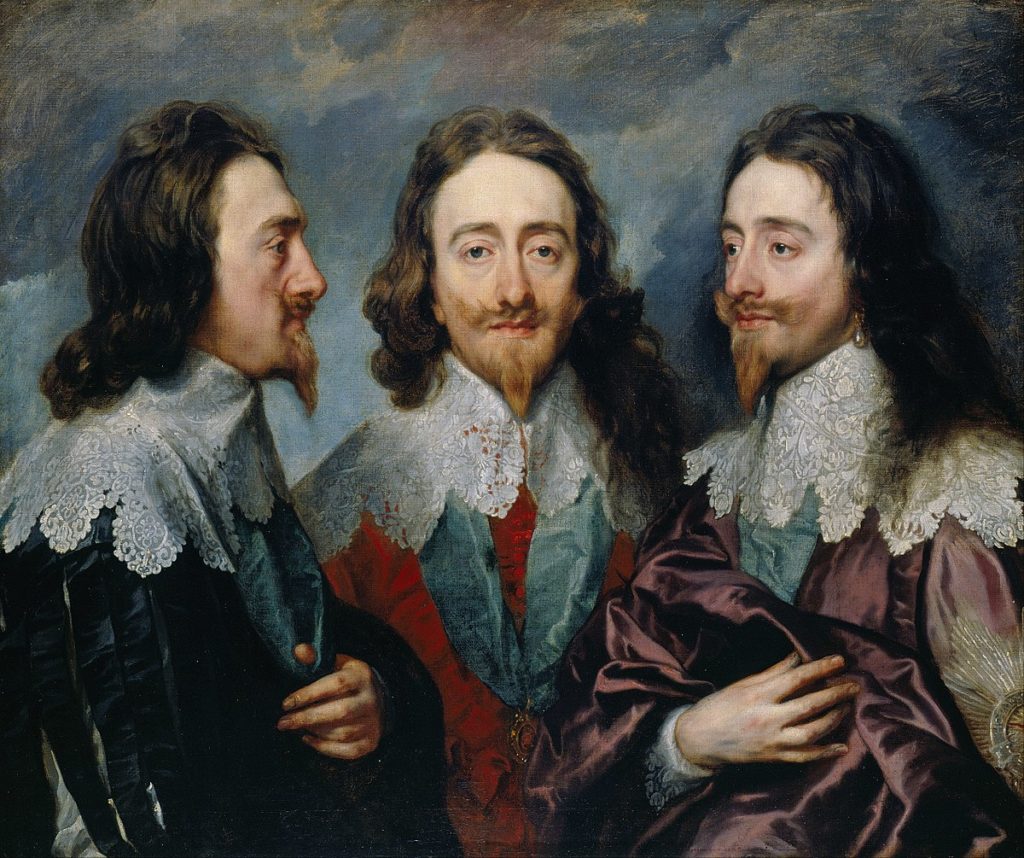
6. Van Dyck, Charles in Three Positions, 1653, Windsor Castle
This famous painting of Charles I was intended to be sent to the sculptor Gian Lorenzo Bernini in Rome, who was to carve a bust of Charles I.
Van Dyck was known for his ability to penetrate below the surface and reveal hidden aspects of the sitter’s personality.
In this triple portrait, he makes Charles seem shy, dignified, and intelligent. Perhaps the drapery on the right connotes a certain love of luxury.
Bernini finished carving the bust in 1636. It was the finest bust of its kind in Britain. Unfortunately, it was destroyed by fire in 1698.
>>> Click there to book a ticket to Windsor Castle
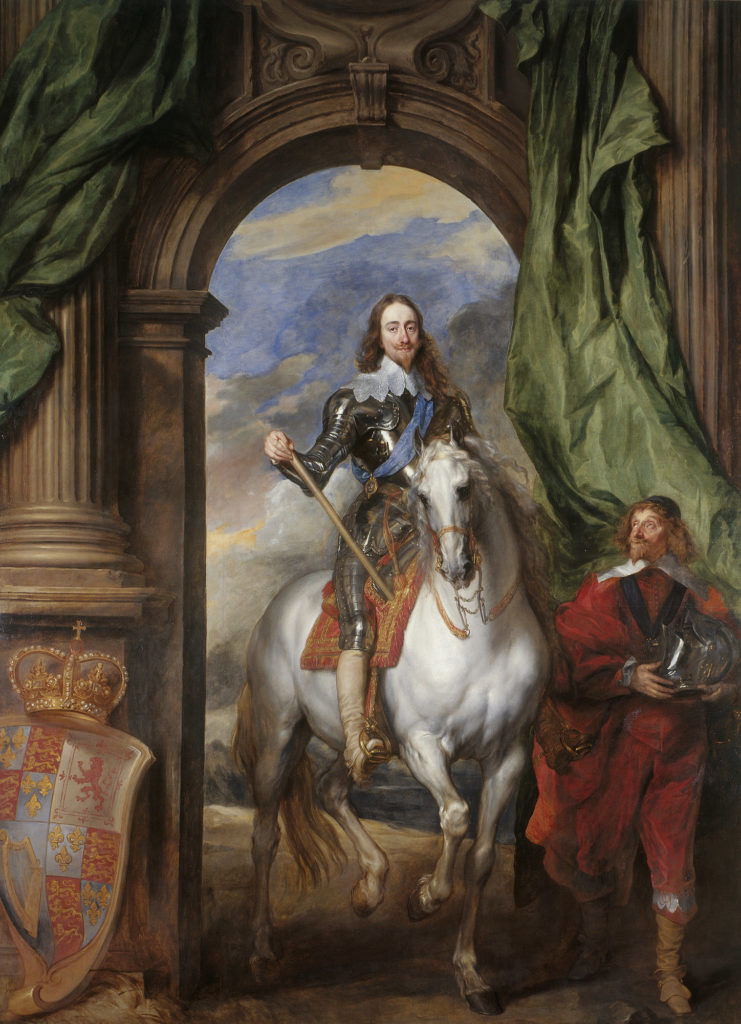
7. Van Dyke, Charles I with Monsieur de St. Antoine, Windsor Castle
This is an official equestrian portrait of Charles I by Anthony Van Dyke housed in Windsor Castle. You may recognize it from the TV show Downton Abbey, where a replica appeared in the dining room.
Equestrian portraits were usually reserved for military and political leaders, a tradition that dates back to Ancient Rome. They’re intended to convey the subject’s gravitas, or ability to lead and conquer all enemies.
Charles I was in need of some portraiture propaganda. He was physically prepossessing (his adult height was 5 feet 4 inches) and suffered from a speech impediment.
In this portrait, Charles is shown in full armor riding a white horse through a triumphal arch. Such arches were used to commemorate military victories. It suggests that Charles is the natural heir to triumphant emperors of the classical world.
The painting is divided into three parts — a coat of arms, the king, and a figure dressed in red. Billowing green drapery frames the scene. Though he has all the trappings of power, there’s a tinge of melancholy in Charles’ expression.
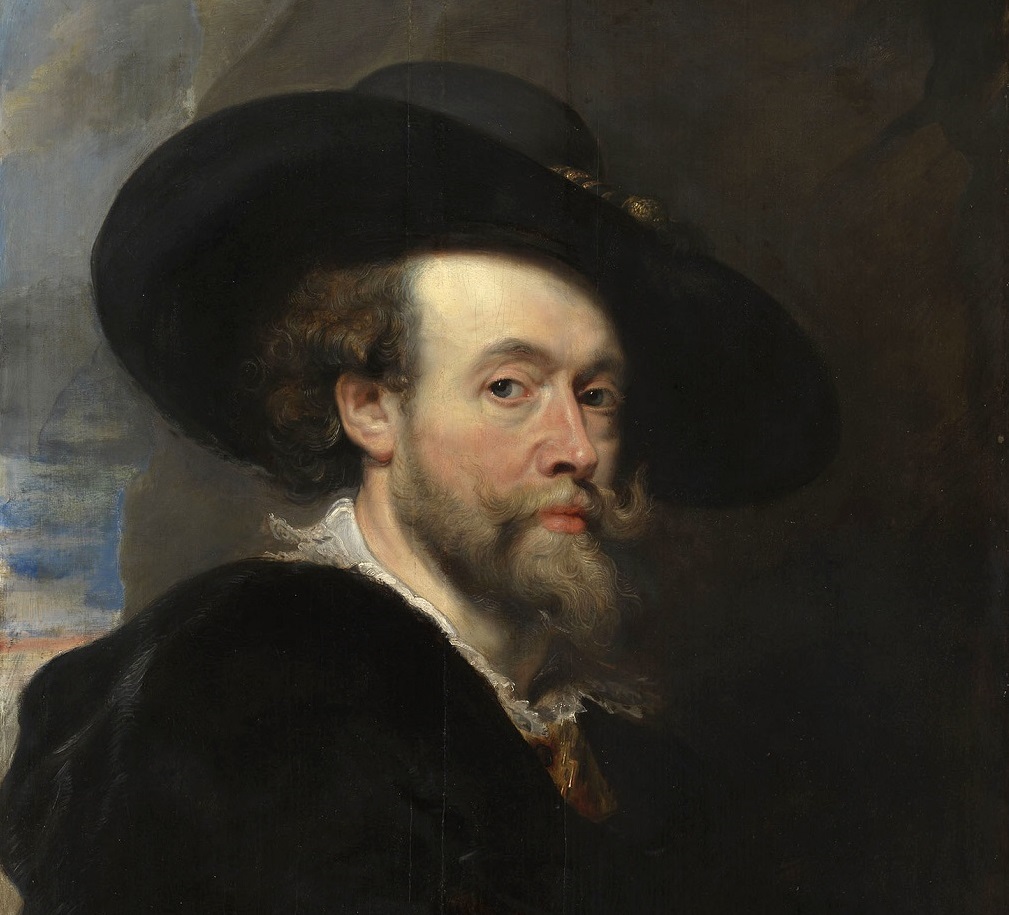
8. Rubens, Self Portrait, Buckingham Palace
Rubens created this self portrait to try to gain the favor of Prince of Wales, who would go on to be crowned Charles I.
Rubens is portrayed as a courtier and diplomat, wearing sober (but fashionable) black clothing.The portrait has beautiful contrasts of light and dark, with shades of deep black.
It’s a bold rendering, which suggests that Rubens was at home in royal circles. He paints himself as an equal, not a supplicant.
The gift of the self portrait was successful and Rubens received steady employment from the English Court. Rubens, in turn, considered Charles I “the greatest amateur of paintings among the princes of the world.”
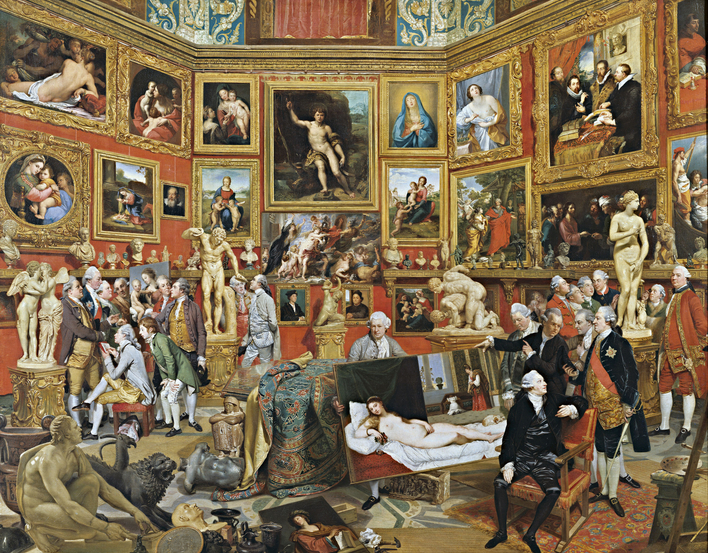
9. Johann Zoffany, Tribuna of the Uffizi, Windsor Castle
George III and Queen Charlotte were fascinated with the Renaissance art of Florence.
They commissioned Johann Zoffany to paint the Tribuna room of Florence’s beloved Uffizi Gallery. Now, it’s one of the most famous paintings in the British Royal Collection.
The monarchs hadn’t been to Italy, so Zoffany recreated the experience of “the grand tour” for them. The Tribuna was the repository of the greatest art works of Florence’s ruling dynasty, the Medici.
Zoffany captures the public’s obsession with the art collection. He paints the assembled paintings, sculptures, and the nobility who are there admiring the works.
Zoffany took a few liberties with the painting. He added in a few pieces from the Pitti Palace, to richen the visual effect. You can see painting by Titian, Correggio, Raphael, Carracci, Guercino, and Rubens.
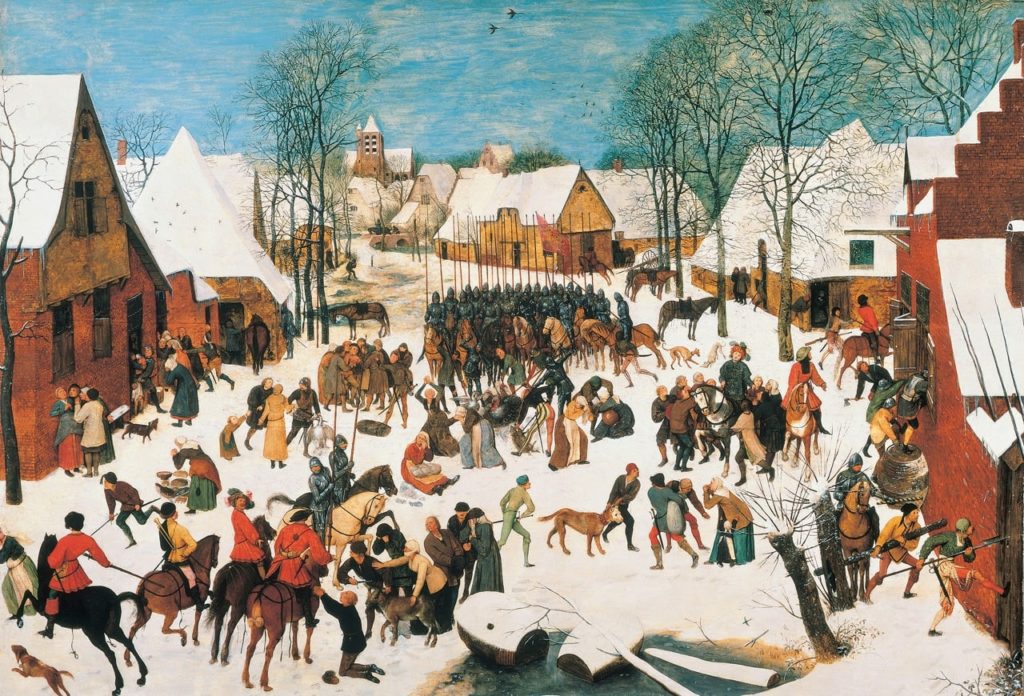
10. Pieter Bruegel the Elder, Massacre of the Innocents, Windsor Castle
This is one of the most famous landscape paintings in the British Royal Collection. It was painted by Netherlands artists Pieter Bruegel the Younger. The artist’s landscapes tend to be littered with allegories and proverbs.
In Massacre of the Innocents, the subject is ostensibly the slaughter carried out by King Herod. It was the official political response to the news of Christ’s birth.
It’s a scene of naked aggression, as a phalanx of mounted Roman soldiers enter the village. Bruegel’s figures show a gamut of emotion from fear, horror, pity, and grim determination.
Bruegel doesn’t depict the menacing scenes in Palestine. Rather it’s set in a Netherland-ish village.
Despite the terrible crimes being committed, birds fly in the air and humans urinate. The landscape becomes a commentary on the human condition.
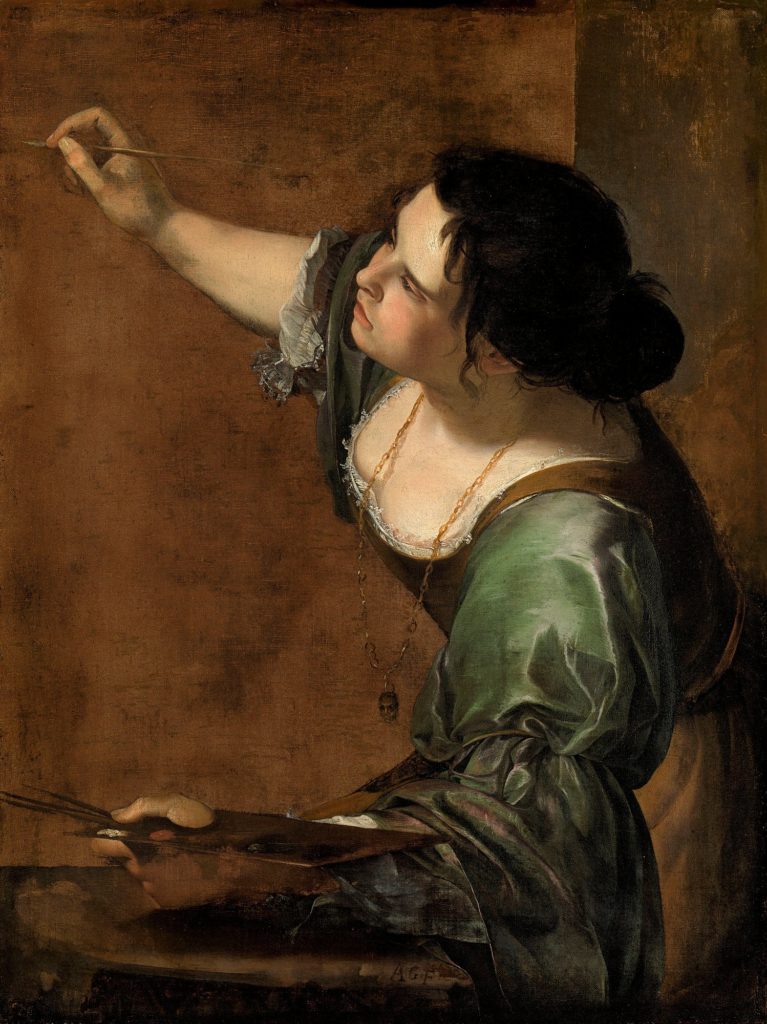
11. Gentileschi, Self Portrait as an Allegory of Art, Palace of Holyroodhouse
This famous painting in the British Royal Collection is Artemisia Gentileschi’s most celebrated self portrait. In her usual tenebrist style, she depicts herself poised and ready to realize her vision on an empty canvas.
And she’s not meek. She looks forceful, the brush as her weapon.
Artemisia boldly portrays herself as the female personification (allegory) of art, at a time when most women couldn’t even pick up a brush. Her gold necklace, with the dangling mask, is a symbol of Pittura, or personified painting.
Some art historians have wondered whether Artemisia might have intended the painting to be a send up of the many pretentious portraits by male artists depicting themselves at work. But it’s probably just evidence of theoretical sophistication or her commitment to art.
But there’s another possible reading. Artemisia had just arrived in London when she painted the self portrait. It could thus be interpreted as an advertisement for prospective patrons. This one was snapped up by Charles I.
READ: Guide To the Life and Paintings Of Artemisia Gentileschi
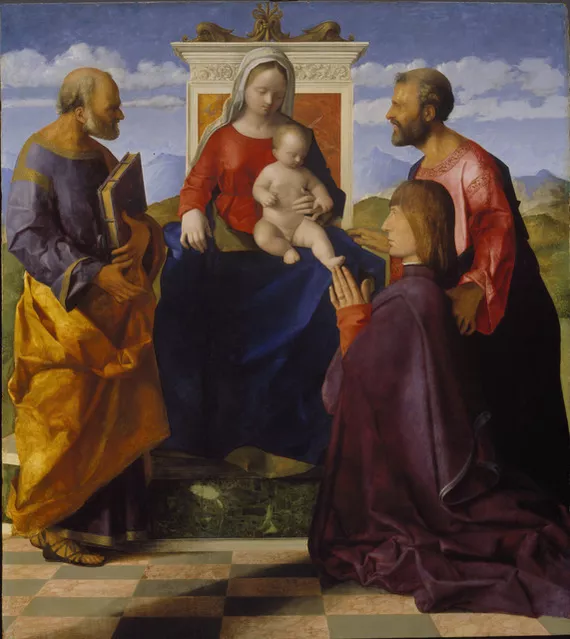
12. Bellini, Virgin and Child with Saint Peter, Saint Mark, and a Donor, Royal Academy of Arts
Giovanni Bellini was the first great Venetian painter. He was the leading artist of the day, tutoring a younger generation that included Titian and the enigmatic Giorgione.
Bellini was a sensitive and adept colorist. He was also lauded for his ability to create realist renderings and his choice of subject, which ranged from landscapes to mythological narratives.
The painting is a beautiful symmetrical arrangement of the Virgin Mary. The painting has rich hues and it beautiful portrays the natural light.
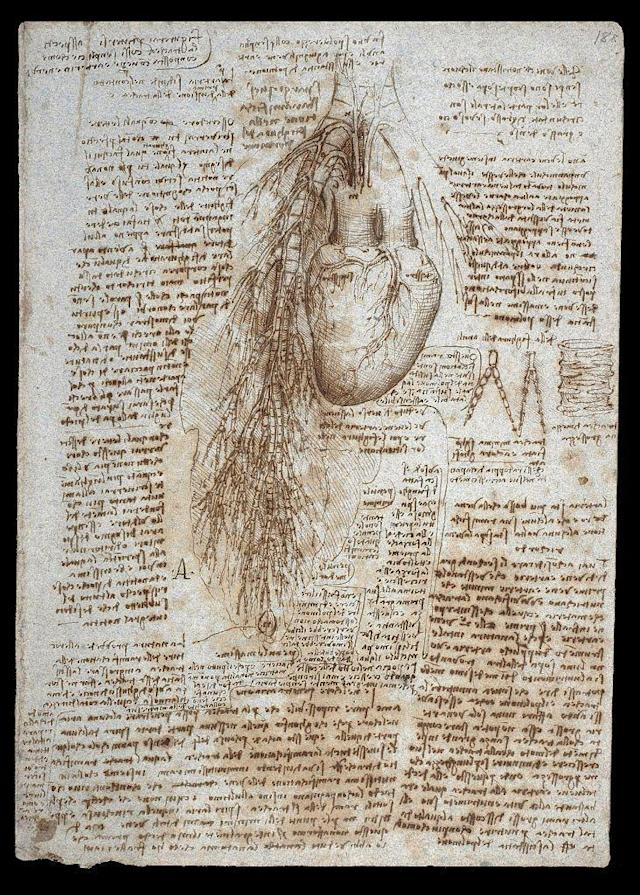
13. Leonardo da Vinci, Anatomical Drawings
The Royal Collection owns over 600 drawings by High Renaissance master Leonardo da Vinci. These are some of the most famous and precious art works in the Royal Collection.
Through drawing, Leonardo attempted to record and understand the world around him. There are only 15 or so authenticated paintings by Leonardo. So, his drawings are the main source of our knowledge of the extraordinary Renaissance man.
The drawings were acquired in an album by Charles II. Queen Victoria took them out of the binding and mounted the drawings individually.
Leonardo’s drawings show the extraordinary scope of his interests — painting, sculpture, engineering, zoology, botany, mapmaking, and anatomy.
He also different media – pen and ink, red and black chalks, watercolor and metalpoint.
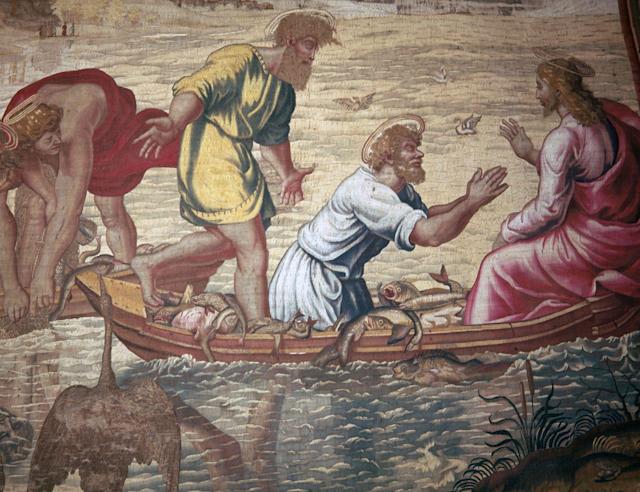
14. Raphael, Cartoon of the Miraculous Draft of Fishes, Victoria & Albert Museum
This is one of seven “cartoons” commissioned by Pope Leo X in the early 16th century to hang in the Sistine Chapel. The cartoons are huge, full-scale designs for tapestries.
They depict key episodes of the lives of Saint Peter and Saint Paul, the founding fathers of the Christian church.
The cartoons are now all displayed at the Victoria and Albert Museum in London. The tapestry from the Miraculous Draft of Fishes was purchased by the future King Charles I in 1623.
The cartoon depicts one of the founding moments of Christianity – when the Jewish fisherman Simon, later renamed Peter, is called to be an apostle of Jesus.
The tapestry was displayed in the Sistine Chapel in 1519. It’s probable that Raphael saw it and even supervised its installation in the chapel.
>>> Click here to book a tour of the V&A
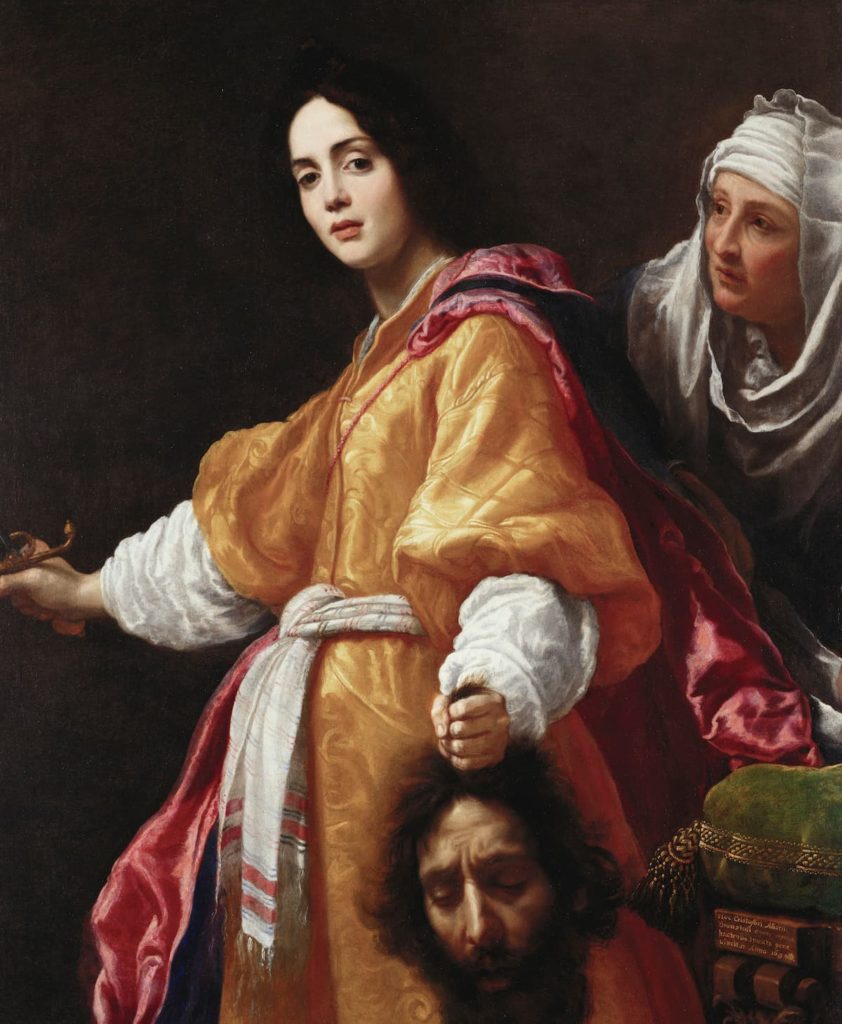
15. Cristofano Allori, Judith with the Head of Holofernes, Buckingham Palace
Allori was a Florentine painter in the late Mannerist period. This painting is a dramatic rendering of the Bible story of Judith and Holofernes. It’s Allori’s most famous painting.
It depicts the Old Testament story of Judith and Holofernes, in which a heroic woman beheads the warlord who’s besieged her town in Israel.
In Allori’s rendering, Judith is calm and cool, resplendent in a gold gown. She looks at the viewer and offers the decapitated head.
The painting is the perfect combination of beauty, violence, and emotional intensity. And it’s effectively a break up story.
Allori gave Judith the face of his ex-lover, from an affair that ended badly. The head of Holofernes is a self portrait of Allori.
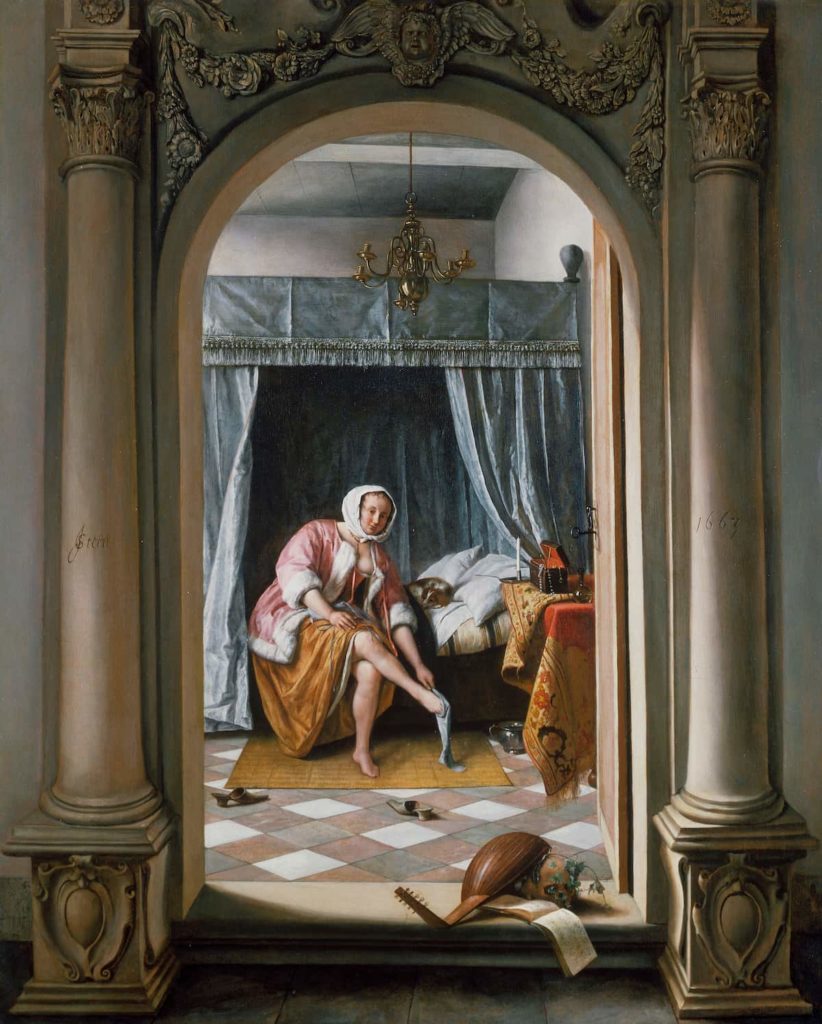
16. Jan Steen, A Woman at her Toilet, Buckingham Palace
Jan Steen was the humorist among Dutch Gold Age painters. He created nearly 800 paintings, most with a moral beneath the wit. In fact, moral ambiguity was a central concern of many 17th century Dutch artists.
In this painting, the woman is seen through an elaborate archway flanked by Corinthian columns. Beyond the arch, a door leads to a bedroom where a woman is, rather proactively, putting on her stockings.
She’s a prostitute. You can tell this from her pose, the disheveled bedding, and the open jewelry box with pearls spilling out. The broken lute string also symbolizes the loss of chastity.
The subject of the painting is base love, not true love. But it’s very elegantly expressed nonetheless.
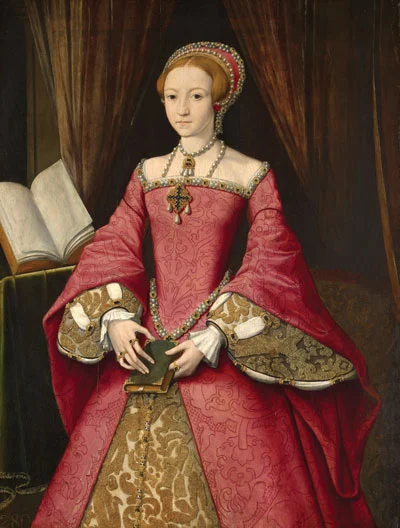
17. William Scrots, Elizabeth I When a Princess, Windsor Castle
This famous painting in the British Royal Collection depicts Elizabeth I before she ascended to the throne. It was probably painted for her father, Henry VIII. It’s the earliest surviving image of the monarch.
Elizabeth is about 13 years old. Her crimson dress is meticulously painted.
She has a contemplative and self possessed look, which is underscored by the presence of a book.
Elizabeth looks almost pious. But she is feminine enough, alluding to her potential as an attractive royal bride.
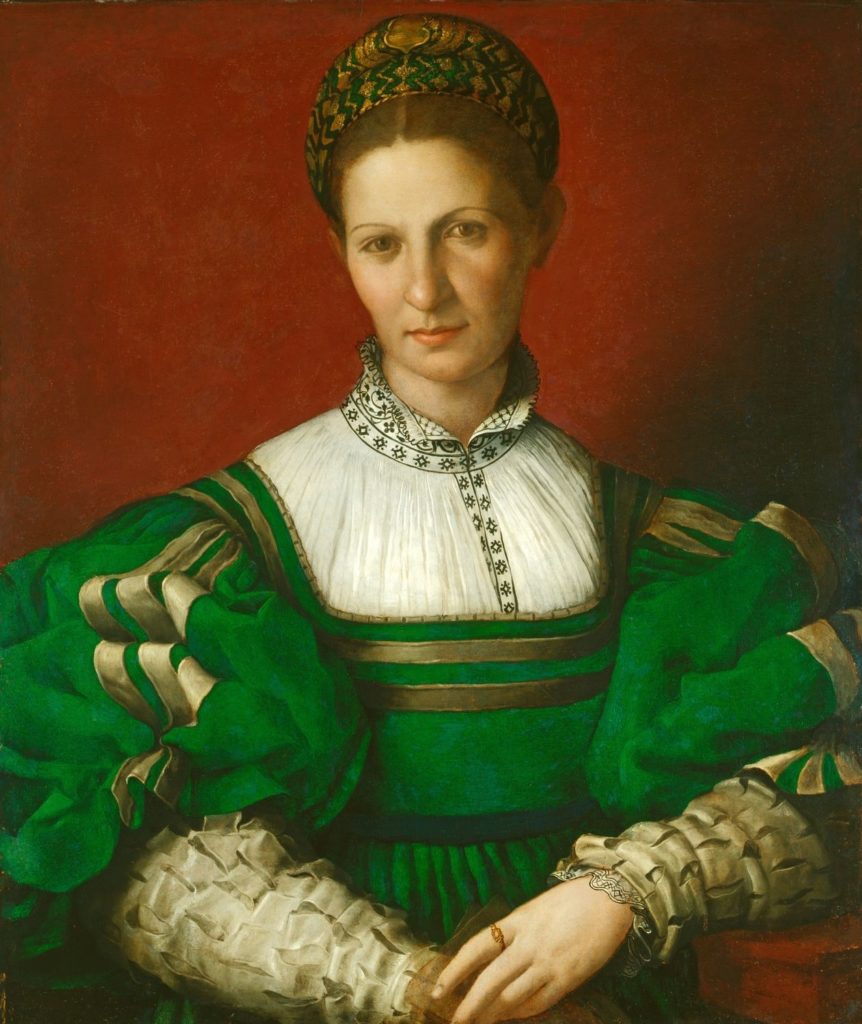
18. Bronzino, Portrait of a Lady in Green, Windsor Castle
Bronzino was a Mannerist (late Renaissance) painter. He’s know as an elegant master of portraiture.
This is an early Bronzino work acquired by Charles I. It shows the influence of his Florentine teacher, Pontormo.
Like most Bronzinos, the portrait is devoid of emotion and yet beguiling in its decoration. The sitter has a direct gaze and simple pose.
There is attention to detail and nice modeling of the slashed sleeves, puffed shoulders, and embroidery.
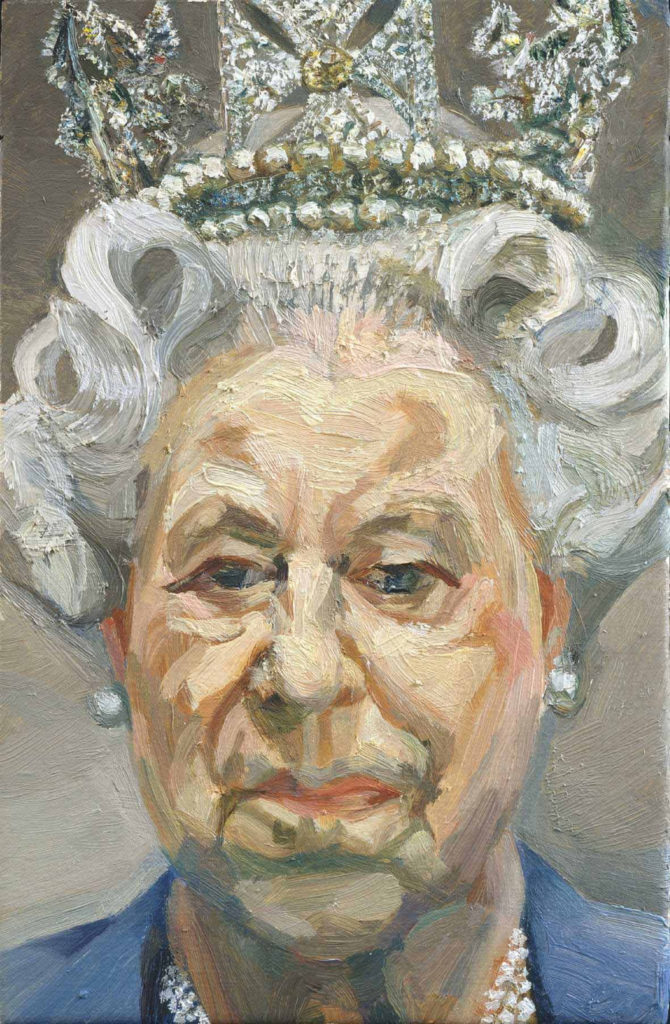
19. Lucian Freud, Queen Elizabeth II, Windsor Castle
Lucian Freud used a style of portraiture that stripped bare the sitter’s social facade. His images were intensely realized and almost intentionally uglified.
Freud painted many portraits of famous people throughout his career. Queen Elizabeth II is perhaps his most powerful and globally recognizable subject. The entire portrait is filled with her rather imposing face.
The portrait was controversial. Freud was accused of painting the Queen in an unflattering light and making her look like one of her corgi dogs.
But really the painting just has his trademark intensity, a trademark he refused to compromise. Some critics argued that it didn’t even look like the queen, suggesting it was stand-in for the artist himself.
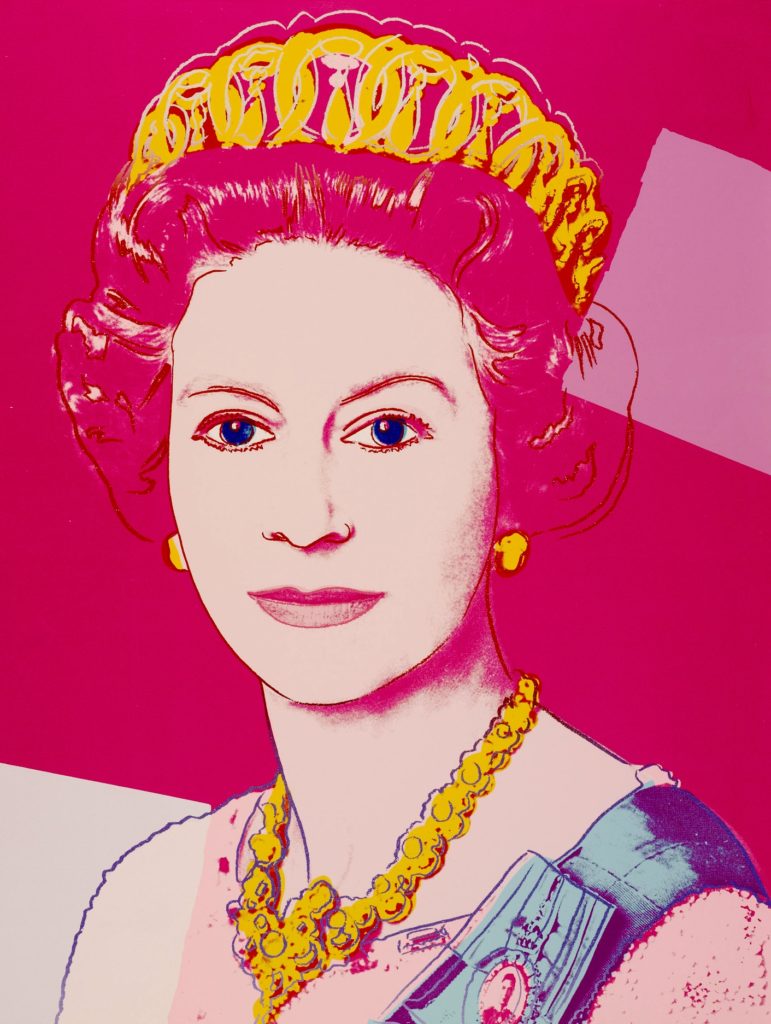
20. Andy Warhol, The Queen, Windsor Castle
The Royal Collection Trust owns four portraits of The Queen by Andy Warhol. They were purchased in 2012 to mark Her Majesty’s Jubilee.
Warhol had a life long fascination with celebrity. He once said, “I want to be as famous as the Queen of England.” Warhol created the images of Elizabeth II in 1985 as part of portfolio of four Reigning Queens.
Warhol used a photograph of the queen taken in April 1975 photographer Peter Grugeon. The photo was later released for official use during the Silver Jubilee in 1977.
The Queen wore the Vladimir tiara, Queen Victoria’s Golden Jubilee necklace, and Queen Alexandra’s wedding earrings.
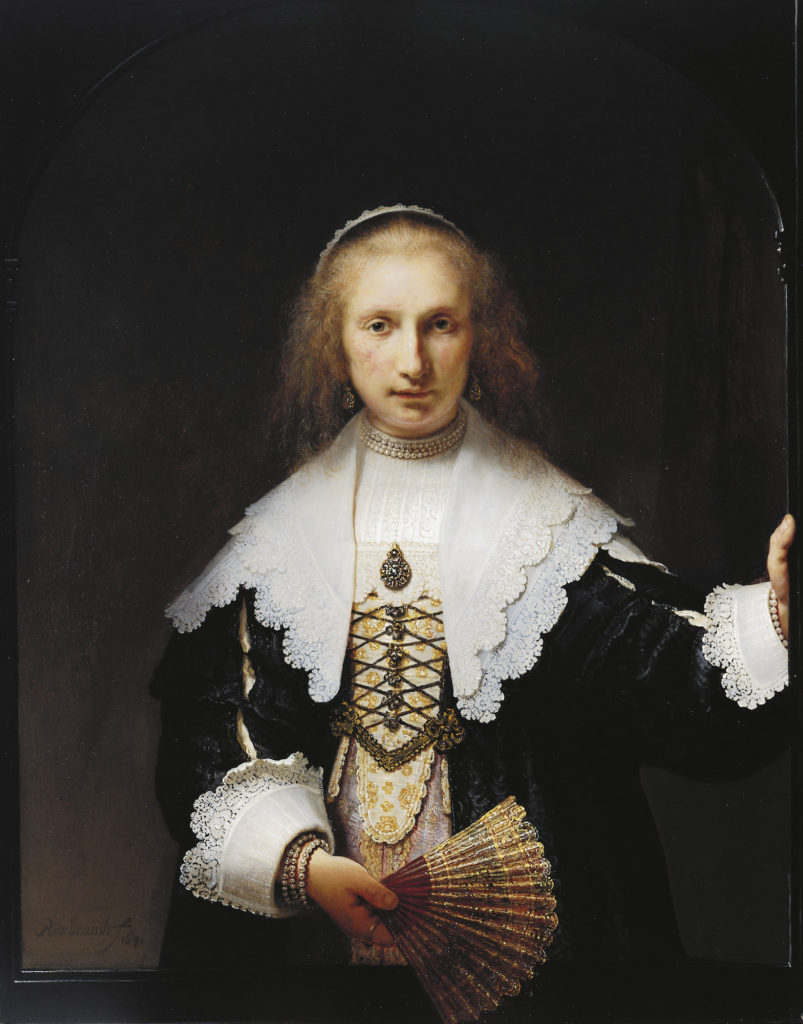
21. Rembrandt, Agatha Bas, Holyrood Palace
There are five Rembrandt paintings in the British Royal Collection. The earliest one, The Artist’s Mother, was acquired by Charles I. It was the first Rembrandt to reach England.
George IV purchased another three Rembrandts, including The Shipbuilder and his Wife. But the most beautiful one is Agatha Bas.
Rembrandt introduced a new illusionistic effect in this painting. The figure is posed within a painted ebony frame, her left hand on the frame. This blurs the boundaries between the the composition and the real world outside.
Rembrandt’s uses chiaroscuro to contrast the woman’s delicate skin with her somber black dress. She appears bathed in natural light.
I hope you’ve enjoyed my guide to the famous paintings in the British Royal Collection. You may enjoy these other London and England travel guides:
- 3 Day Itinerary for London
- 5 Day Itinerary for London
- Best Museums in London
- Harry Potter Places in London
- Guide to the National Gallery of Art
- Guide to St. Paul’s Cathedral
- Guide to the Tate Britain
- Guide to Wesminster Abbey
- London Tourist Traps To Avoid
- Guide to the Tower of London
- Guide to the Churchill War Rooms
If you’d like to see the British Royal Collection paintings, pin it for later.

